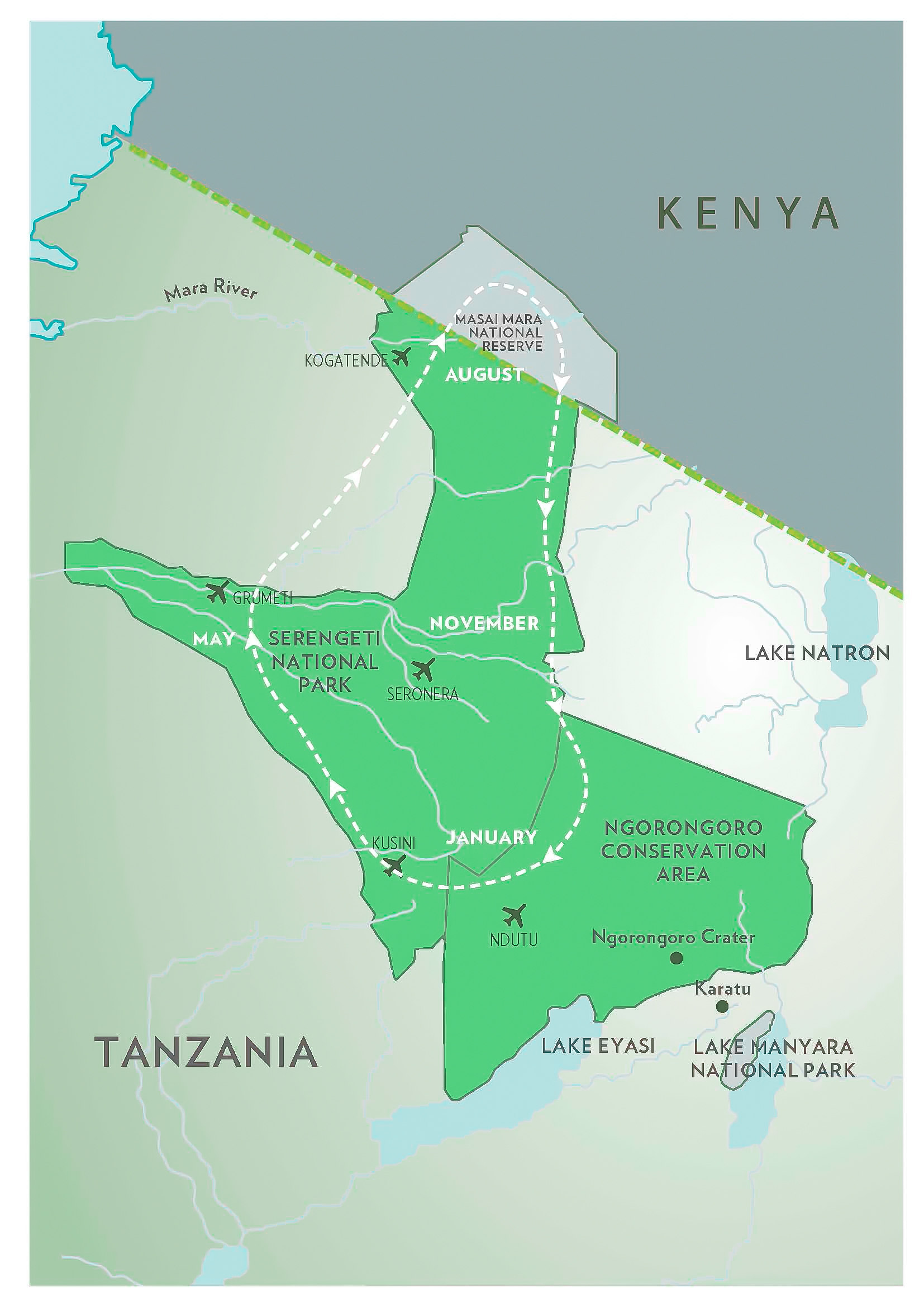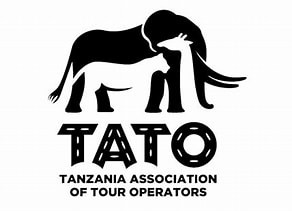La partie sud-est du Serengeti, la région de Ndutu, est riche en animaux sauvages tout au long de l'année, mais le nombre d'animaux atteint son apogée entre décembre et avril. D'immenses troupeaux de gnous et de zèbres sont attirés par les pluies saisonnières. À cette période, les plaines autour du lac Ndutu, où se concentrent les troupeaux de gnous, constituent la meilleure zone d'observation du gibier. La plupart des petits naissent en janvier et février, soit environ 8 000 par jour. Les plaines d'herbe rase leur offrent une certaine sécurité, les prédateurs étant plus facilement repérables. Néanmoins, comme c'est le cas dans la nature, ces jeunes gnous attirent de nombreux prédateurs affamés, tels que les lions, les guépards, les léopards et les hyènes. D'autres espèces comme les gazelles et les zèbres mettent également bas et utilisent les jeunes gnous comme couverture pour détourner l'attention de leurs propres petits. La région est également propice à l'observation des oiseaux, Autruches, vautours, cigogne marabout. Outardes, pies-grièches, super volailles, tisserins, inséparables, flamants roses, oiseaux aquatiques, hérons, sont les oiseaux les plus répandus dans cette région.
Après le petit-déjeuner, route vers la région de Ndutu où vous assisterez à la migration des gnous et des zèbres.
Fin décembre, la grande migration arrive généralement avec ses 2 millions d'animaux à Ndutu. Les gnous, les zèbres et les gazelles viennent ici pour donner naissance à leurs petits et y restent jusqu'en avril. Des milliers d'animaux naissent chaque jour de décembre à mars.
L'herbe de cette zone est riche en nutriments pour les jeunes animaux. Et comme elle est courte, les adultes peuvent repérer de loin les prédateurs qui s'approchent. C'est donc un endroit sûr pour élever les jeunes zèbres et gnous.
Ndutu est une région très belle et riche en animaux sauvages. De plus, c'est la seule réserve naturelle de Tanzanie où l'on est autorisé à conduire hors route. Cela vous permet d'approcher les animaux de très près. De nombreux prédateurs sont attirés par les vêlages qui ont lieu ici et parcourent cette vaste région. Camp Kenzan.
Le meilleur endroit pour observer les animaux est autour du lac Ndutu, où d'énormes troupeaux se rassemblent. Il s'agit d'un lac alcalin peu profond situé à la frontière orientale du parc national du Serengeti.
En 1973, les rives du lac Ndutu ont accueilli un site de fouilles archéologiques d'environ 140 mètres carrés qui a conduit à la découverte du crâne de Ndutu et de plusieurs restes d'outils datant d'il y a plus de 500 000 ans. Aujourd'hui, il sert de source d'eau pour les animaux et partage le même bassin que le lac Masek, situé à une courte distance à l'est, mais à l'intérieur de la zone de conservation du Ngorongoro.
Les forêts et les Kopjes de granit autour du lac Ndutu abritent également de nombreux animaux en dehors des mois de migration. 3 nuits Nuit à Camp Kenzan.
Après le petit-déjeuner, nous ferons un safari dans la région de Ndutu, puis nous nous rendrons à Karatu où nous passerons la nuit. Marera Valley Lodge.
Après le petit-déjeuner au lodge, route vers Mto wa Mbu pour une visite culturelle aux femmes locales et apprendre comment elles mènent leurs activités quotidiennes, notamment l'agriculture et les groupes de microfinancement des femmes. Vous goûterez à la cuisine africaine locale. Après le déjeuner, retour en voiture à Aéroport d'Arusha ou aéroport du Kilimandjaro.

| 1 personne | 2 personnes | 3 Personnes | 4 Personnes | 5 Personnes | 6 personnes | 7 Personnes |
|---|---|---|---|---|---|---|
| $3869 | $3044 | $2769 | $2631 | $2549 | $2494 | $2454 |
La grande migration a lieu en mai et juin
Une fois la saison des pluies terminée, les plaines du sud et de l'est du Serengeti s'assèchent, ce qui déclenche le début de la migration. Celle-ci débute généralement en avril ou en mai, lorsque les troupeaux commencent à se déplacer vers le nord et l'ouest, mais pas toujours en un seul groupe cohérent.
Du 1er au 15 juillet : Le corridor occidental et Lobo, au nord du parc. Les riches herbes du corridor occidental permettent de garder les troupeaux plus longtemps que prévu, mais début juillet, la Grande Migration passe généralement par Lobo et se dirige vers le nord du Serengeti.
Il est stupéfiant de voir des centaines de milliers d'animaux se déplacer tous ensemble. Comme de nombreux animaux dépendent des gnous et des zèbres pour se nourrir, la migration attire de nombreuses autres espèces en se déplaçant à travers le paysage, ce qui permet d'observer des espèces diverses de façon unique.
Ils commencent à suivre le schéma de la pluie. Là où il y a de la nourriture et de l'eau fraîche. La migration peut changer d'une année à l'autre en raison de l'imprévisibilité du temps. Environ 2 millions de gnous entreprennent ce long voyage avec les zèbres, les élands, les gazelles et les impalas.
Pour les saisons 2022 et 2023, nous vous recommandons de planifier votre voyage à la mi-juillet, car c'est à ce moment-là que la migration commence typiquement, avec les plus grands troupeaux de gnous qui commencent à se déplacer dans le Masai Mara. La migration se poursuit jusqu'à la fin du mois d'août, avant de décliner jusqu'à la mi-septembre.
Chaque année, entre mai et décembre environ, des millions de gnous, de zèbres et de gazelles entament un voyage aller-retour entre le parc national du Serengeti, en Tanzanie, et le Maasai Mara, au Kenya. Des prédateurs affamés suivent leurs moindres mouvements, ce qui donne lieu à une expérience de safari inoubliable.18 Feb 2023.
Visitez le célèbre Serengeti, qui abrite une faune abondante ainsi que l'impressionnante migration des gnous. Et l'impressionnant cratère du Ngorongoro, une merveille naturelle avec la plus grande concentration d'animaux sauvages au monde.
Si vous avez des questions sur L'expert du safari
ou si vous souhaitez faire un demande de réservation,

Copyright © Allengeti Adventures | Tous droits réservés
Construit par : Internet360.nl